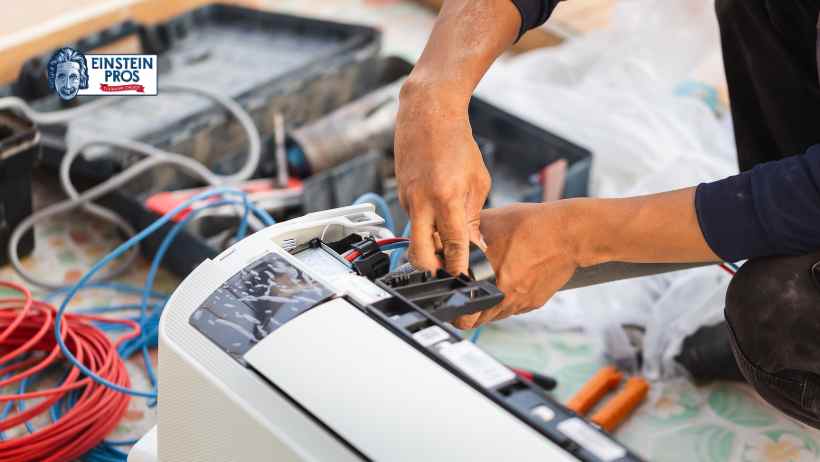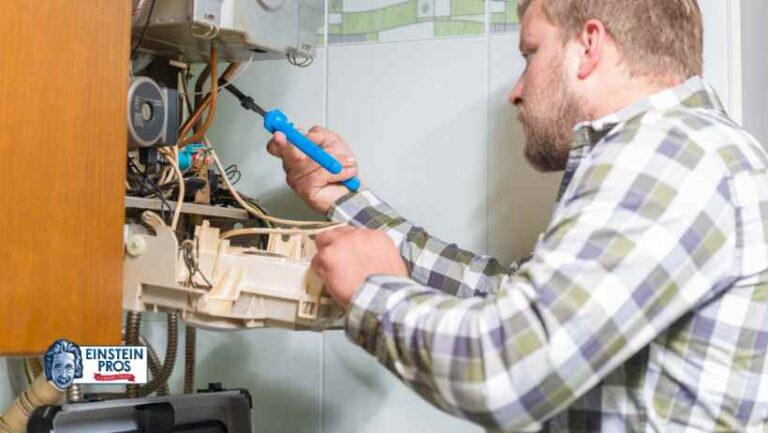Winters can be harsh, and a malfunctioning furnace can turn the comfort of your home into a chilly nightmare. If you’ve ever found yourself searching for furnace repair tips on your furnace blowing cold air instead of hot air, you know how frustrating and uncomfortable it can be. In this comprehensive guide, we’ll delve into various factors that can lead to your furnace blowing cold air and provide practical solutions and prevention tips to avoid this issue again.
10 Causes & Solutions When Your Furnace Blows Cold Air
1. Thermostat Settings:
Cold air blowing from your furnace may be as simple as an incorrect thermostat setting. Check to ensure that your thermostat is set to the desired temperature. If it’s set too low or in the cooling mode, your furnace will blow cold air instead of warm.
Solutions:
Adjust the Thermostat Settings:
- Ensure that your thermostat is set to the desired temperature for heating. If it’s a programmable thermostat, review the programmed settings to rule out any scheduling issues.
2. Air Filter Issues:
A clogged or dirty air filter can impede proper airflow, causing your furnace to overheat and trigger the safety mechanism, resulting in cold air blowing from the vents.
Solutions:
Regularly Replace or Clean Air Filters:
- Check your furnace’s air filter and replace it if it’s dirty. If you have a reusable filter, clean it according to the manufacturer’s instructions. Regular maintenance will ensure proper airflow and prevent the system from overheating.
3. Pilot Light or Ignition Problems:
If your furnace relies on a pilot light or electronic ignition system, malfunctions can lead to cold air blowing from the vents.
Solutions:
Check the Pilot Light:
- If you have an older furnace with a pilot light, ensure that it is lit. If it’s out, relight it following the manufacturer’s instructions.
Inspect the Ignition System:
- For furnaces with electronic ignition, check for error codes on the control panel. If you notice any issues, consult the manufacturer’s manual or contact a professional technician for assistance.
4. Gas Supply Issues:
Insufficient or interrupted gas supply can cause your furnace to blow cold air. Gas-related problems require immediate attention for safety reasons.
Solutions:
Check Gas Supply:
- Verify that your gas supply is sufficient and that the gas valve is fully open. If you suspect a gas leak, evacuate your home immediately and contact your gas company.
Consult a Professional:
- If you’re uncertain about gas-related issues, it’s crucial to consult a licensed HVAC technician for your local furnace repair.
5. Ductwork Problems:
Leaky or poorly insulated ductwork can lead to heat loss, causing your furnace to blow cold air instead of distributing warm air throughout your home.
Solutions:
Inspect Ductwork for Leaks:
- Examine your ductwork for any visible leaks or gaps. Seal any leaks using duct tape or mastic sealant to improve efficiency.
Ensure Proper Insulation:
- Properly insulate your ductwork to minimize heat loss. This can help maintain the warmth of the air as it travels from the furnace to your living spaces.
6. Malfunctioning Thermostat Sensor:
A faulty thermostat sensor can cause your furnace to inaccurately gauge the temperature, leading to cold air blowing when the actual room temperature is higher than the thermostat setting.
Solutions:
Calibrate or Replace the Thermostat Sensor:
- If you suspect a thermostat sensor issue, you can try recalibrating it according to the manufacturer’s instructions. If problems persist, consider replacing the sensor or upgrading to a new thermostat.
7. Dirty or Faulty Flame Sensor:
The flame sensor is responsible for detecting the presence of a flame. If it’s dirty or malfunctioning, it may prevent the furnace from igniting, resulting in cold air blowing from the vents.
Solutions:
Clean the Flame Sensor:
- Turn off the power to your furnace and gently clean the flame sensor with fine-grit sandpaper. If the problem persists, consider replacing the flame sensor.
8. Overheating and High Limit Switch Activation:
Furnaces are equipped with a high limit switch that turns off the burner if the system overheats. This can lead to cold air blowing as the system cools down.
Solutions:
Check for Overheating:
- Inspect your furnace for signs of overheating, such as a dirty heat exchanger. Ensure that the vents and registers are not blocked to allow proper airflow.
Reset the High Limit Switch:
- Once the furnace has cooled down, locate the high limit switch (refer to the manufacturer’s manual) and reset it. If the problem persists, consult a professional technician for your furnace repair in Bend.
9. Furnace Size and Capacity:
An improperly sized furnace may struggle to heat your home effectively, leading to cold air blowing from the vents.
Solutions:
Consult a Professional for Sizing:
- If you suspect that your furnace is too small for your home, consult with an HVAC professional to determine the appropriate size and capacity for efficient heating.
10. Electrical Issues:
Faulty wiring, a tripped circuit breaker, or issues with the electrical components of your furnace can result in cold air blowing instead of warm air.
Solutions:
Check Wiring and Connections:
- Inspect the wiring and connections in your furnace for any signs of damage or loose connections. Ensure that the circuit breaker for the furnace is not tripped.
Call a Professional Electrician:
- If you’re not comfortable dealing with electrical components, it’s advisable to seek the assistance of a licensed electrician or HVAC technician to diagnose and resolve the issue.
How Do I Prevent My Furnace Blowing Cold Air?
After learning the reasons and possible solutions to your furnace problem, we’ll explore proactive measures you can take to prevent your furnace from blowing cold air, addressing common issues before they escalate into significant problems.

1. Regular Maintenance:
Consistent Check-ups and Cleaning:
Regular maintenance is the cornerstone of preventing furnace issues, including the dreaded phenomenon of blowing cold air. Schedule routine check-ups to ensure all components are in optimal condition, and perform regular cleaning to eliminate dirt and debris that can impede performance.
- Schedule professional HVAC maintenance annually in Bend to inspect and clean the furnace thoroughly.
- Change or clean air filters regularly to maintain proper airflow and prevent overheating.
2. Thermostat Management:
Accurate Settings and Calibration:
The thermostat is the control center of your heating system, and accurate settings are crucial to prevent your furnace from blowing cold air unintentionally. Calibration and proper use of your thermostat can make a significant difference.
- Set the thermostat to the desired temperature for heating.
- Calibrate the thermostat sensor according to the manufacturer’s instructions to ensure accurate temperature readings.
3. Air Filter Replacement:
Regular Changes for Uninterrupted Airflow:
A clean air filter is essential for maintaining airflow and preventing overheating. Regularly replace or clean your furnace’s air filter to ensure efficient performance.
- Check the air filter monthly and replace it if dirty.
- If using a reusable filter, clean it according to the manufacturer’s instructions.
4. Pilot Light and Ignition System Inspection:
Continuous Monitoring for Reliable Ignition:
For older furnaces with a pilot light and newer models with electronic ignition, regular inspection is vital to prevent interruptions in ignition that may lead to the circulation of cold air.
- Inspect the pilot light periodically for older furnaces and relight if necessary.
- Check for error codes on the electronic ignition system for newer models and address issues promptly.
5. Gas Supply Assurance:
Secure and Steady Gas Connection:
Maintaining a consistent and secure gas supply is critical for preventing your furnace from blowing cold air. Regularly check the gas valve and address any interruptions promptly.
- Ensure the gas valve is fully open to facilitate proper combustion.
- If you suspect a gas leak, evacuate your home immediately and contact your gas company.
6. Ductwork Integrity:
Sealing Leaks for Efficient Heat Distribution:
Leaky or poorly insulated ductwork can lead to heat loss and cold air circulation. Regularly inspect and seal any leaks to ensure efficient heat distribution throughout your home. Broken ductworks can be a costly furnace repair.
- Visually inspect ductwork for leaks or gaps.
- Seal any visible leaks using duct tape or mastic sealant.
7. Thermostat Sensor Care:
Recalibration and Replacement:
A malfunctioning thermostat sensor can cause your furnace to misjudge the room temperature, resulting in cold air circulation. Regularly recalibrate or replace the thermostat sensor to ensure accurate temperature readings.
- Periodically recalibrate the thermostat sensor according to the manufacturer’s instructions.
- Consider replacing the sensor if you notice inaccuracies in temperature readings.
8. Flame Sensor Maintenance:
Regular Cleaning for Uninterrupted Ignition:
The flame sensor is crucial for detecting the presence of a flame. Regular cleaning ensures uninterrupted ignition, preventing the furnace from blowing cold air due to ignition issues.
- Turn off the power to the furnace and gently clean the flame sensor with fine-grit sandpaper.
- If cleaning doesn’t resolve the issue, consider replacing the flame sensor.
9. High Limit Switch Awareness:
Monitoring and Resetting:
The high limit switch is a safety feature that prevents overheating. Being aware of its status and resetting it when necessary can help maintain a consistent flow of warm air.
- Periodically inspect the furnace for signs of overheating.
- If the high limit switch is activated, wait for the furnace to cool down and reset it following the manufacturer’s instructions.
10. Proper Furnace Sizing:
Consultation for Efficient Heating:
Ensuring that your furnace is appropriately sized for your home is fundamental to preventing issues like cold air blowing. Consult with an HVAC professional to assess and, if necessary, upgrade your furnace for efficient heating.
- Consult with an HVAC professional to determine the appropriate size and capacity for your home.
- Upgrade to a properly sized furnace if your current one is inadequate.
Why Choose Einstein Pros For Your Furnace Repair?
When it comes to furnace repair, Einstein Pros stands out as the premier choice for clients seeking reliable and professional service. With a stellar reputation built on a foundation of expertise, integrity, and customer satisfaction, Einstein Pros has proven itself as a leader in the industry. The team of highly skilled technicians at Einstein Pros possesses extensive knowledge and experience in diagnosing and repairing a wide range of furnace issues.
From providing accurate estimates to explaining the repair process in understandable terms, the company fosters a relationship of trust with its clientele. Additionally, Einstein Pros prioritizes punctuality and efficiency, ensuring that clients’ heating systems are restored promptly..
Conclusion:
A furnace blowing cold air can be caused by a range of issues, from simple thermostat settings to more complex problems with gas supply or electrical components. Regular maintenance, prompt identification of issues, and professional assistance from Einstein Pros when needed are crucial for keeping your furnace in top condition. By addressing these factors systematically, you can restore warmth to your Bend home and ensure your furnace operates efficiently throughout the winter months.
